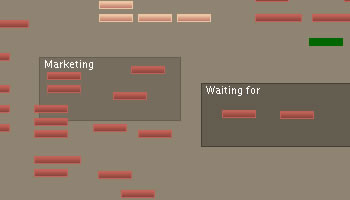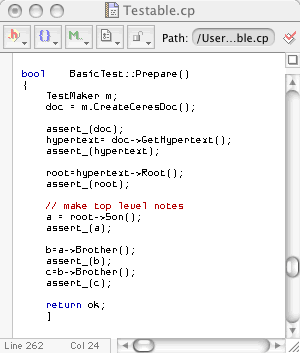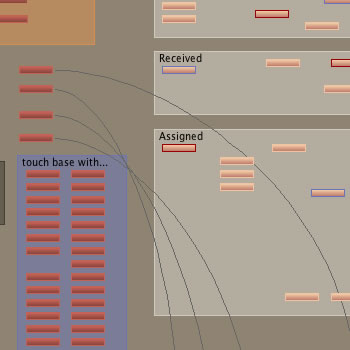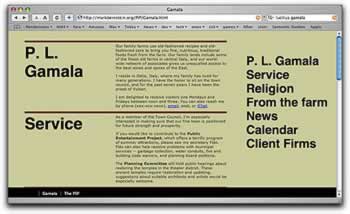Welcome to Ava Marie Zeldman.
Reviews and responses to Ted Goranson's discussion of Tinderbox:
- Grey Notebook: "The program is so adaptable that it resists definition or classification. This makes “training manuals” problematic. I think you have to throw yourself into the application and live with it over a long time. I’ve been a big champion of Tinderbox for a couple of years and I learn something new about it regularly. Instead of turning to a manual and looking passively for ideas, expecting Eastgate to te;l me what to do with the program, I simply try and do everything in Tinderbox."
- Dave Rogers: " I keep meaning to delve more deeply into the things Tinderbox can do apart from maintaining this weblog. I'm not sure it'll percolate to the top anytime soon, but the impetus is growing with each update. Ted Goranson's Deep Tinderbox is an exhaustive look at the application, and worth your time if you're interested in Tinderbox. I've corresponded with Ted on outliners for the Mac, and the work he's producing for ATPM in the About This Particular Outliner series is really remarkable. It's an enormous asset and valuable resource for Mac users."
- Tinctoris: "I finally got around to fiddling with some of the new Tinderbox eyecandy; it was hidden deep down in the interface. I've gone gradient crazy!"
We've got the network up, and finally found chairs for everybody; Tinderbox weekend is under way!
People from down the street, from the East coast, from Japan. Screen writers, librarians, psychologist, professors of English. Lots of Tinderbox expertise.
Elin Sjursen's information gardening exercise was a big hit; lots of excitement bursting out all over the room, as Tinderbox veterans discovered features they'd always overlooked. (A lot of people didn't know you could magnify the map view. Who knew?)
It was interesting to observe how many people preferred making agents to popping up the Find dialog -- even though Tinderbox's Find offers fast incremental search.
Update: Alwin Hawkins blogs the weekend.
Ted Goranson continues his study of outliners with Deep Tinderbox, an 11,000 word study that explore the program with great thoroughness and intelligence.
While much of the rest of the world seems to be drifting away from spatial leverage, Tinderbox stands out all the more. To me, it seems more Mac-like than much of the Mac these days.
Tinderbox is as powerful an outliner as you will find so long as you don’t need an editable inline view, or large numbers of graphics. As an information management assistant, it exploits techniques you will find in no other non-research software and really can be life-altering.
Goranson concludes with a fascinating list of suggestions for new users. I don't agree with all of these completely, but I think everyone might find them useful. Don't miss them!
Has anyone, anywhere, explored a software genre as thoroughly as Goranson's study of outliners (outliners?) sets out to do?
For Tinderbox Weekend, I've been writing some notes about using Tinderbox for ongoing team planning.
It's an interesting problem. A lot of software in this area focuses on tracking people and resources -- often assuming you're scheduling to optimize equipment and resolve scheduling conflicts. That's what you need for a construction site or a machine shop, but it's not a common office situation.
Tinderbox works really well for keeping track of things -- things you want to do, things someone should think about, things that need to be checked before you ship. It lets you build a nice, informal plan -- the sort of thing you might put on a whiteboard -- and let it evolve over time in an open, collaborative but disciplined setting.

This is a small piece of a huge document, and it's zoomed way out where you can't see any of the detail. But you can see we've got a bunch of marketing tasks, and a bunch of other marketing-related tasks lying around the edges. The bright pink notes designate ideas; the green note is something that needs to be done this week.
Tinderbox works really nicely with a projector as a meeting aid, but the map zooming is nice enough that it's fine, even with big projects, on a 12" screen. Which is how I spent the 5 hours en route to San Francisco, sitting next to a guy who was doing Excel spreadsheets a 17" screen. (Tinderbox 2.3 has some nice new zoom chrome, and since nobody has blogged it yet I'll do it myself)
We're off to San Francisco and Tinderbox Weekend West. If you're planning to come and haven't registered yet, it's OK. But it would be helpful to register in advance anyway, so we can be sure the table is big enough!

And, even if you can't make it to the weekend, do come to dinner!
Alas, since we're bound to the Golden Gate we can't join Ted Nelson and Nate Matias and company at WWW@10, which is also this weekend. Nate's paper on Truth, Trust and the Textual Camera was written with Tinderbox.
J. P. Butler has found TypeIt4Me (via Merlin Mann and Mark Hurst) helps save time when using Tinderbox as a Daybook:
It can do smart datestamps, so I defined 'ds' as inserting a datestamp. I track everything through Tinderbox, and I'm constantly typing in the datestamps as I'm taking notes while working on my various projects. This little feature just saved me a minimum of 15 minutes every single day.
He also uses TypeIt4Me for an Amazon link macro. Of course, you could do both of these with Tinderbox macros inside Tinderbox, but that only works in Tinderbox...
We'll meet at Pazzia Caffe -- 337 3rd Street (map) at 8PM. (It's a nice walk from the Rex, where we're having Tinderbox weekend.
No need to RSVP, but if you think you can make it, won't you email me so we can let the restaurant know how big a table we need?
Only a week to go, now, 'til Tinderbox Weekend in San Francisco.
One of my favorite tinderbloggers just signed up! Hooray! It's going to be interesting to meet Tinderboxers from all over the West (and a few from a lot farther afield). But we'll be small enough to fit into a fun little hotel, to sit around a big table, and to actually sit down and talk. It's going to be great.
This afternoon, I'll be polishing a section on "Planning With Tinderbox" for The Tinderbox Way. With luck, we'll get that into the handouts, along with a fresh take on Personal Information Places.
This important and thoughtful consideration of role playing game theory by Ron Edwards was recommended by Paranoia legend Greg Costikyan. It starts at an unusual place:
My straightforward observation of the activity of role-playing is that many participants do not enjoy it very much. Most role-players I encounter are tired, bitter, and frustrated.
A key lesson (and nicely turned phrase) on incoherent game design is a useful caution for interactive drama theory:
... The Great Impossible Thing to Believe Before Breakfast: that the Game Master may be defined as the author of the ongoing story, and, simultaneously, the players may determine the actions of the characters as the story's protagonists.
Costikyan's review of the No Press Anthology is the occasion for a fascinating survey of independent RPG design, which I strongly recommend to everyone interested in interactive narrative.
A useful discussion at the relocated Typographica explores good screen fonts for programming.
I grabbed a copy of Galexica from MyFonts, just because it's not much like Monaco. Sometimes, different is nice: simply making a change in your work environment helps focus your attention and make you more productive. Step right up and make yourself a Hawthorne Effect! Thanks, 43 Folders!

I'm making the transition from Prosperity, the TinderBook, to a new 12" Powerbook.
I ordered the new laptop earlier this year when Prosperity's hard disk failed, but I've been procrastinating over making the move. But Tinderbox Weekend is coming up in a week's time, and two transcontinental trips in four days is a very good reason to start using the smaller and lighter new laptop.
Incidentally, for the last month I've had four systems side-by-side on my desk: the two Macintosh laptops, the Windows laptop, and my desktop G5. I'm a firm believer in lots of screens and lots of CPUs, but four is too many; I can't keep four machines occupied productively.
Tinderbox 2.3 has lots of new code for dealing with files -- work that was motivated by Tinderbox for Windows but that also makes it much easier to move Tinderbox documents to a new machine. Still, there might be some breakage here -- especially as I'm using a radically experimental Tinderbox build right now. If you notice a problem, let me know.
Dunstan Orchard makes an interesting point: since Fitts' Law reminds us it's easier to click larger link targets, it makes sense to design links in navigation lists so they use the entire list width, not just the text. A simple CSS tweak does the job. Thanks, Eric!

From Thailand, Marisa Antonaya writes about Off The Shelf: The Reading Project, a new site which uses Tinderbox to feed XML to a Flash viewer.
Meanwhile, Anders Fagerjord finds that there's no wireless at AoIR:
It's fun to watch all the frustrated bloggers, repeatedly throwing their hands in the air, exclaiming 'WHERE IS THE WIRELESS?!' It's a situation where Tinderbox is an excellent blog environment. I can blog offline, and just upload whenever I get access.
Dave Sifry asks whether Tinderbox and Getting Things Done are a meme.
Of late I've been hearing more and more about “Getting Things Done” (aka GTD) and programs like Tinderbox. Seems that there's some new management trend starting to spread.
In other interesting classroom news, blogsperiment reports on Adrian Miles's journalism course on Hypertext Theory and Practice, where students we expected to write hypertexts with Storyspace and to keep blogs.
The new Tinderbox maps have some interesting new features. These may seem to be prettification (or chart junk), but I think you'll find they make hard-nosed sense.
Here's a working document I'm using for medium-term TEKKA planning, using the new Tinderbox 2.3 features.

- This is a custom color scheme; I like to use different color schemes in each Tinderbox task, so I can more easily remember what I'm doing if I'm interrupted.
- I don't have much color sense, so I enjoy books that suggest nice color schemes. Tinderbox 2.3 lets me enter colors as RGB codes right out of the books, and also gives me better access to the color pickers.
- Most of the notes have borders. Border style, thickness, and color are now attributes. Here, borders tend to represent subtypes. Light-colored notes are articles and article ideas. Blue borders distinguish reviews, red borders distinguish fiction. These get inherited by prototypes (or assigned by agents), so they're no extra work.
- The notes have gentle gradients. Again, this gives agents and prototypes additional degrees of freedom. Secondary color and gradient style are attributes, too, and so they're easy to manage.
I just learned something about Tinderbox: you can link one Tinderbox to another.
- Put the file URL of the Tinderbox file into a note's URL attribute; this might be something like: file://localhost/Users/[your name here]/Documents/[your-file].
- Set ViewInBrowser to true.
Now, whenever you open a text window on this note, Tinderbox will also open another Tinderbox document.
It's a free upgrade if you bought Tinderbox within the last year. Other Tinderbox users can upgrade for \$70 -- which gets you another full year of free upgrades, too.
There's a lot of great new stuff in this release. It's faster. It looks even better. It's even more open. It generates better HTML and XML. And we've opened up some exciting new horizons for agents and actions.
I'll be talking about some of these new features in the coming days. But don't just stand there -- head over to Eastgate and get the upgrade, OK?
In a brilliant LiveJournal story, a New York subway rider fights back against crazed, homophobic preachers with the classic weapon of New York minorities: the show tune! Thanks Diane!
I just noticed that Flickr lets you play the testimonial game, just like Orkut and LinkedIn.
It seems to me that “testimonials” are about flirtation, and the prominence of flirtation in social software makes Elin's TEKKA series on dating (Here be Matches) even more interesting.
Five technically legal signs suggests ways that librarians might evade the Patriot Rule that forces them to turn over people's reading records to the FBI, without revealing the investigation to anyone.
Someday, we'll marvel that we permitted this -- and everyone will tell their grandchildren that someone else supported these outrageous and foolish laws.
New from But She's A Girl: a fine discussion about the theory and practice of the Getting Things Done methodology -- with Tinderbox.
Storyspace 2.5 is intended to closely follow the familiar Storyspace experience. It's a loving recreation of the storied writing environment. But, in addition to faster launching and better reliability, we do have some nice bonus features in store:
- spell checking
- better font rendering for nicer reading
- self-contained Storyspace readers
Best of all, the new tech foundations of Storyspace 2.5 will let us undertake research in new narrative forms (and new products!) much more readily than ever before.
If you're an experienced Storyspace user and you'd like to participate in the test program, feel free to email me.
I wrapped up the Tinderbox files I mentioned yesterday as a new Tinderbox assistant. If you already own Tinderbox 2.2, you can download it here. (128K)
Improvements, corrections, and great alternate styles are very welcome indeed. Email me.
We'll be talking about building export templates and wizards like this at Tinderbox Weekend San Francisco, October 2-3. Join us!
Erin Starr reports that the improvised prison used to house protesters arrested in New York City during the convention was leased and operated by the Republican Party. (I can't find confirmation of the story, yet)
Kathryn Cramer asks: should we just start calling it The Party?
My neighbor was recently asking, should we give a small donation to the GOP, so when they start making lists of enemies of the state, we won't be at the top?
Meanwhile, from atrios:
This morning, I spent a couple of hours putting together a simple Tinderbox template for a Personal Information Page, or Pip.
Not everyone needs a weblog, but almost everyone needs some web presence. Suppose your second cousin Bess wants to invite you to her daughter's wedding: she needs a way to find you. Suppose you meet someone at a party, and six months later they have a question for you -- if only they knew how to get in touch. The PIP is a weblog for people who don't want a weblog, a home page for people who don't live on the Web.
Tinderbox can work nicely in this role. We can use agents to extract key elements from a larger, private ToDo list. Or, we can simply drag things into the Pip as we need them. Tinderbox takes care of organizing and formatting. Most importantly, it's easy to add things -- and Tinderbox can automatically sort the lists that ought to be sorted
Here's a rough cut at an example, and here's a little more information about the Pip, presented as a Pip(!).

If you're a Tinderbox user and would like to suggest improvements or work on the design of the PIP template, email me.
Both wines went very nicely with the grilled filet mignon and fresh sweet corn, grilled in the husk. The Australian seemed awfully tannic at first, but improved a lot as the night went on. So, for that matter, did the Crozes Hermitage, which wasn't very tannic to begin with. Wine is like that.
As I was leaving Barnes and Noble today, preparing to head for the cash register, I stopped by the Current Events table. With one or two exceptions, it was completely Republican. Swift boat liars, wall to wall.
I mentioned this to the nice people at the nearby customer service desk. They said it was company policy -- there was nothing they could do.
I thanked them for reshelving the books I was planning to buy, and left.
I'm glad to see that a recent article in The Guardian finds the internet has actually helped a number of British independent booksellers.
Martin Fowler explains closures, a programming-language construct from the modern LISP/Smalltalk/Ruby school of flexible (and agile) programming.
An odd feature of the craft of software is that, for many of us, languages and development environments got worse in the late 1980's, when the LISP machine era collapsed, and took ten or fifteen years to recover. Back then, a first-rate developer workstation cost about $30K. Now, it's less; development managers hated the idea of a workstation that cost as much as a car.
I'm still not sure why a company would want to take a team of developers, each of whom costs $150K per year, and give them $500 workstations and cubes.
Anja Rau draws an interesting connection between informal sorting techniques such as vague boxes and Cathy Marshall's jeremaid (in TEKKA 6) against the Semantic Web.
In TEKKA 6, George Landow reads William Mitchell's Me++:
Mitchell, a justly famous proponent of new technologies of communication, shares a good deal with the Victorian sages — Carlyle, Ruskin, and Arnold — and the Old Testament prophets who served as their inspiration.
Mitchell, an architect and authority on the intersection between the digital and the built environment, believes technology matters. Some dismiss this belief as naive American technodeterminism. It's almost automatic: as soon as you find a technology that matters, there's a professor at your elbow telling you that technology doesn't matter and besides it will cause untold harm in the hands of the American military-entertainment complex.
What confounds me is that these people think their staunch defense of the established order to be a profoundly liberal and leftist position. It's like the wingers who are voting for Bush because they think Clinton lied.
If you believe in Progress, you should get on with the job of building a better world. If you don't believe in progress, stop pretending you care about working people.
This is an interim release, a stepping stone on the way to the long-awaited Storyspace 3. In many ways, it's a loving recreation of the original Storyspace. But the little improvements (spell check! Quartz font rendering!) and solid new engineering will make a real difference right now.
Tim Bray delivers an important and insightful lecture on digital rights management and the coming debacle. A must-read.
My younger readers may find this incredibly weird but it’s true: Not so long ago, it was illegal to buy a telephone. You could only rent them from the phone company, which had all sorts of good arguments why this was necessary to protect the integrity and quality and viability of the telephone network.
We're headed back to the dark ages, thanks to the politicians and to the lying liars that abet them.
Merlin Mann's 43 Folders gives a nice introduction to Getting Things Done. He also does a nifty series on Quicksilver, a MacOS X enhancement that I've never quite bonded with.
I also like the sidebar item, Tools I Like. I'm a sucker for sidebars in blogs, of course, but this is original and intriguing. I wish more people did this. What's in your toolbox?
For example, lots of people talk about using version control systems to manage their working files. Version control lets you keep backups efficiently and keeps them organized; you can say, "show me how Chapter 7 looked back in May", and get the answer right away. Here's Martin Fowler:
I've long been in the habit of using CVS to backup my working directory, and now I use MultipleDesktops I find a source management system essential to keep everything in sync. A month or so ago I subverted my repository. I can now report that all is working really well and I'm very happy with the change.
But how does this work in practice? Do you keep all your projects in one directory tree? Doesn't that tree get filled up with lots of big files (graphic documents, object libraries) that you don't want clogging up your repository? How do you do it?
The first page of the Globe today has a story about a huge puzzle that Google posted in the Harvard Square subway station.
{first 10-digit prime found in consecutive digits of e}.com
Also puzzling me yesterday was email, telling me that Netflix had just dispatched Laurel Canyon to me. "What," I wondered, "is Laurel Canyon? " I checked IMDB and Rotten Tomatoes, and read Ebert's review, but I couldn't qujite fathom why I wanted to see it. Then, serendipitiously, I found the answer on Flickwerk.
What a sweet little movie by Lisa Cholodenko. It is a movie about living your life, not allowing yourself to be tied down by the rules of family-expectation, career-requirements, childhood-wrongs etc. etc.... Laurel Canyon is slow and heavy and giggly like a late summer afternoon spent smoking pot by the pool, listening to guitar-pop with semi-deep lyrics.
When I decide to act on a movie suggestion, I put the movie right onto my Netflix list. It's another case of write it down: get the idea and the intention in concrete form, immediately. But I also need to write down the reason and context, or I won't understand why I'm doing what I'm doing.
For example, someone told me to get Terry Pratchett's Mort during Hypertext '04, but David Millard insists it was someone else entirely.
James Vornov finds the Tinderbox-as-Whiteboard idea has power far beyond ephemeral planning.
The reason the whiteboard seems to work is that I can see the titles of all of the components at once in a map view. Outline views, whether a conventional outline or a mapped outline don't easily allow me to look as broadly.
The power of the Map view -- the power of spatial hypertext -- is one of the most interesting facets of Tinderbox. Someone should study this systematically.
With all these fascinating research topics lying all over the lawn waiting for a scholar to wander by and gather them, we might perhaps indulge in a little less swordplay over controversies like the interdisciplinarity of ludology -- controversies with little operational consequence and less potential to influence the art and practice of software.
Anja Rau (Flickwerk) raises a very important point about weblogs.
Most ideas are half-baked when they turn up first. Communication is a good antidote. But who'd be willing to play advocatus diaboli to your inklings at the drop of a hat?
One answer, of course, is that journals and weblogs are perfect.
Another is suggested by the opening line of the post; your partner can usually be relied on to read and respond:
Talked to N. about blogging again. It seems that another benefit of the blog is that it gives the writer a format to write *and think* into.
But it doesn't always work that way. My father and my mother were both writers, and they had a pretty good relationship for a very long time, but neither could read the other's writing with any sympathy at all. And, sometimes, the page and the World are simply better listeners than someone with whom you're living.
Anja takes Die Zeit to task for a letter that characterizes Swedes as blonde women who live in red houses. I read this as a response to Jill's plaint on gendered metaphor in computing. Gender is part of language.
But then again, my wife has a treasured 19th century photograph of her great grandmother, doubtless blonde, standing in front of a tiny farmhouse, doubtless red. Her daughter had died young, her son-in-law wasn't sure (according to family memory) he could handle three little girls, and so the children and the old lady would soon head for the farms of Long Island.
Palimseste de Gwenael has an interesting post about Tinderbox and Active Renderer. But my French just isn't up to it.
As it happens, I'm working on a new TEKKA feature that uses javascript outlining, which is a big part of ActiveRenderer. (This was also part of the Tinderbox Weekend materials for Boston, though it hasn't caught on amongst Tinderboxers yet.) So, there's a good chance I might have something to say -- if only I knew what.
If a Francophone Tinderbox users could insert themselves into the discussion, that'd be a big help! Lazy web!
Russ Lipton surveys a wide range of weblog and writing tools. He says:
Tinderbox (one of the most powerful pieces of personal software ever created) will remain my personal tool of choice for writing.
Meanwhile, Daryl Richter has crafted nice new RSS 2.0 templates for Tinderbox. You can download them here. Thanks!
The latest issue of TEKKA is out. For starters, don't miss Cathy Marshall's stunning and hilarious connection between the Semantic Web and late-night informercials, Taking A Stand on the Semantic Web.
Elin Sjursen takes an interesting look at dating sites in Here Be Matches, too.
In the beginning, looking for love online felt a little like entering Peter Pan's Never Never Land, where dreams are born and time is unplanned. Tapping the keyboard lightly, my fingertips brought a seemingly endless number of tall, dark, smiling knights...
I've been thinking, lately, about how many really interesting hypertext research problems are lying right on the surface, waiting for someone to pick them up. So plentiful are these low-hanging fruits, in fact, that it's really shameful how many dull research papers we're all asked to referee.
For example, consider Tinderbox aliases. An alias is a placeholder -- it appears separately in the map and the outline, but in most other respects it refers to an original note it represents.
Aliases respond to a long-standing frustration in hypertext systems with a hierarchical backbone, a lineage that reaches back through Storyspace to KMS and Guide: what do you do if you aren't sure whether a note goes here or there? Links, of course, are one answer, especially if the hierarchy is not very significant. But, where the hierarchy matters, it can be very hard to know where to put some things.
Now, what does it mean to make a link from a note to an alias? It might mean, "I want a link to the original, of which the alias is merely a handy delegate."
But, it might mean, "I want a link to the alias -- just what I said!" The position of the alias in the outline might, for example, reflect an aspect or facet, and we might expect to preserve that.
For example, if the hierarchy has a taxonomic flavor, the alias of sweet filed under Wine is not precisely the same as the alias of sweet filed under Temperament, and we could imagine wanting to link to one or the other even though there's really one underlying object.
Or, we might follow Stotts and Furuta's Trellis and say, "a link to an alias is implicitly a multi-tailed link to all the aliases and to the original."
Perhaps other semantics are possible, too. What are they? Which one is right?
This is a research topic, lying in plain sight, with almost no previous literature. You could tackle the problem without programming, without equipment, without needing anything beyond insight and imagination. It's got intellectual challenge and heft. It's got practical consequences: it's already a feature in shipping, commercial software and nobody knows the right answer. (Thanks to a Tinderbox customer, who raised the question in correspondence)


